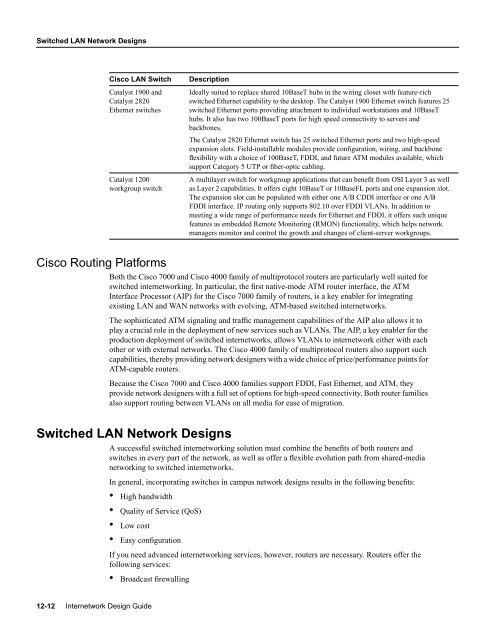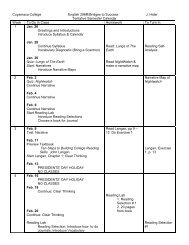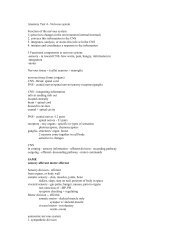Designing Switched LAN Internetworks
Designing Switched LAN Internetworks
Designing Switched LAN Internetworks
Create successful ePaper yourself
Turn your PDF publications into a flip-book with our unique Google optimized e-Paper software.
<strong>Switched</strong> <strong>LAN</strong> Network DesignsCisco <strong>LAN</strong> SwitchCatalyst 1900 andCatalyst 2820Ethernet switchesCatalyst 1200workgroup switchDescriptionIdeally suited to replace shared 10BaseT hubs in the wiring closet with feature-richswitched Ethernet capability to the desktop. The Catalyst 1900 Ethernet switch features 25switched Ethernet ports providing attachment to individual workstations and 10BaseThubs. It also has two 100BaseT ports for high speed connectivity to servers andbackbones.The Catalyst 2820 Ethernet switch has 25 switched Ethernet ports and two high-speedexpansion slots. Field-installable modules provide configuration, wiring, and backboneflexibility with a choice of 100BaseT, FDDI, and future ATM modules available, whichsupport Category 5 UTP or fiber-optic cabling.A multilayer switch for workgroup applications that can benefit from OSI Layer 3 as wellas Layer 2 capabilities. It offers eight 10BaseT or 10BaseFL ports and one expansion slot.The expansion slot can be populated with either one A/B CDDI interface or one A/BFDDI interface. IP routing only supports 802.10 over FDDI V<strong>LAN</strong>s. In addition tomeeting a wide range of performance needs for Ethernet and FDDI, it offers such uniquefeatures as embedded Remote Monitoring (RMON) functionality, which helps networkmanagers monitor and control the growth and changes of client-server workgroups.Cisco Routing PlatformsBoth the Cisco 7000 and Cisco 4000 family of multiprotocol routers are particularly well suited forswitched internetworking. In particular, the first native-mode ATM router interface, the ATMInterface Processor (AIP) for the Cisco 7000 family of routers, is a key enabler for integratingexisting <strong>LAN</strong> and WAN networks with evolving, ATM-based switched internetworks.The sophisticated ATM signaling and traffic management capabilities of the AIP also allows it toplay a crucial role in the deployment of new services such as V<strong>LAN</strong>s. The AIP, a key enabler for theproduction deployment of switched internetworks, allows V<strong>LAN</strong>s to internetwork either with eachother or with external networks. The Cisco 4000 family of multiprotocol routers also support suchcapabilities, thereby providing network designers with a wide choice of price/performance points forATM-capable routers.Because the Cisco 7000 and Cisco 4000 families support FDDI, Fast Ethernet, and ATM, theyprovide network designers with a full set of options for high-speed connectivity. Both router familiesalso support routing between V<strong>LAN</strong>s on all media for ease of migration.<strong>Switched</strong> <strong>LAN</strong> Network DesignsA successful switched internetworking solution must combine the benefits of both routers andswitches in every part of the network, as well as offer a flexible evolution path from shared-medianetworking to switched internetworks.In general, incorporating switches in campus network designs results in the following benefits:• High bandwidth• Quality of Service (QoS)• Low cost• Easy configurationIf you need advanced internetworking services, however, routers are necessary. Routers offer thefollowing services:• Broadcast firewalling12-12Internetwork Design Guide
















